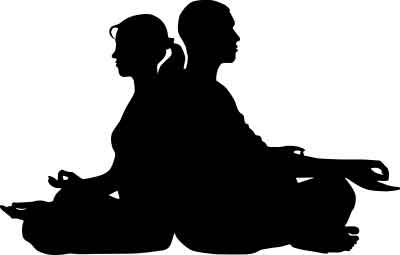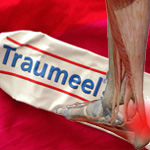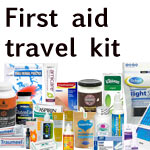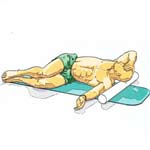Chances are if you are exercising regularly you will suffer an injury at some point. Most of us have had minor sports injuries such as a sprain, strain, muscle pulls or tears in the past.

Image-courtesy-of-artur84-FreeDigitalPhotos.net
The traditional recommendation has been the RICE principle:
- Rest
- Ice
- Compression
- Elevation
Over the last few years a several of studies have shown that resting and icing an injury may actually delay tissue healing. Even Dr. Mirkin who promoted the RICE principle in 1978 has started to change his mind, you can read his new point of view here.
Various studies tested different icing and compression combinations on extensive muscle soreness from extreme exercise load. Cooling delayed swelling, but it did not increase recovery speed from this muscle damage. A combination of ice and compression had little effect on the healing speed compared to the use of compression by itself. Interestingly icing plus gentle exercise may marginally help to heal ankle sprains.
Why stopping circulation through icing stops the healing process
The body uses the same immune system function that it uses to kill germs to deal with any tissue damage you incur through trauma, be it muscle muscle soreness from exercising or a muscle strain.
Healing is actually an inflammatory process. Whether it is germs got into your body or body tissues that were damaged, your immune system sends the same inflammatory cells to the damaged tissue to promote healing. Which means the response to both infection and tissue damage is the same. Inflammatory cells rush to injured tissue to start the healing process.
Applying ice to reduces swelling actually delays healing by preventing the body from triggering the inflammatory healing response as well as restricting the delivery of vital nutrients to the cells in the injured area.
Icing causes blood vessels in the injured area to constrict and shut off the blood flow that brings in the healing inflammatory cells. You may think but I am just using the icing to stop the pain. You need to consider that once the blood vessels have shut off they do not open again for many hours after the ice was applied. Apart from missing out on the initial healing process you may also experience tissue to die from decreased blood flow as well as permanent nerve damage.
I think the problems restricted blood flow cause give us a good idea why slow and steady movement practices such as Yoga or Tai chi are so healing. They increase circulation gently without increasing overall blood pressure to unhealthy levels. Coupled with deep breathing which promotes increased oxygen levels in the blood we have a winning formula. The body needs good circulation to each and every cell, it is vital that the blood bring nourishment and oxygen to the cells location since they can not go shopping for what they need to survive. 😉
So what can you do to speed up the healing of an injury?
Most of use want to take an active part in making ourselves feel better. Doing nothing just doesn’t feel right does it?
If you haven’t read my Traumeel post from last week you may think, well I can always still take pain killers NASIDs such as Ibuprofen or Diclofenac. Again they really do more damage then good, check the table of side effects in the Traumeel post as well as realise that they are called non-steroidal anti-inflammatory because they block the enzymes that trigger both swelling and pain.
Anything that reduces inflammation also delays healing!
In short healing is delayed by:
- most pain-relieving medicines
- cortisone-type drugs
- immune suppressants that are often used to treat arthritis, cancer or psoriasis
- applying cold or ice packs
- anything else that blocks the immune response to injury
If you would like to stay in touch and stay informed about any new info I put out on related issues subscribe to my news update.
Pain as a warning sign?
Of cause there are many different reasons for pain. Bear in mind that pain is your body’s way of telling you that something is wrong. For most minor injuries it is ok to deal with them by yourself but if you have pain that won’t go away it’s a good idea to get it checked out by a doctor.
My personal approach to dealing with a minor injury would be to stop exercising immediately; to continue doing what caused the pain in the first place is insane. All it does is make things worse. Exercising while in pain doesn’t make you a stronger person but it does take you out of the game for longer.
In cases of severe pain where you may be unable to move, feel confused or even lose consciousness medical attention is highly recommended. Don’t be a hero.
Dr. Mirkin’s new recommendations include the option to elevate the injured part to use gravity to help minimise swelling. Ensure that someone who is qualified determines that no bones are broken and that movement will not increase damage. You can apply compression bandages if the injury is limited to muscles or other soft tissue. Use the pain signal to determine your readiness to return to exercise. You should be pain free before you get back into the full swing of things.
So can I ice to relief pain?
Yes, because applying ice to a fresh injury can help with the initial pain, it is acceptable to cool an injured part for short periods of up to 10 min soon after the injury occurred. Take a 20 minute break and ice for a further 10minutes. After that initial icing for pain relief there is no reason to apply ice. So if you can not ice your injury until six hours after you have injured yourself don’t bother as you will just prolong the healing process increasing the time you will spend waiting to get back to full functionality.
With minor injuries you are usually able to start your rehabilitation the next day providing movement does not increase the pain and discomfort. For severe injuries stick to your doctor’s advice.
We all want to get back to our sport as soon as we can but do so without pain if you care about your fitness and exercise future.

Image-courtesy-of-sattva-FreeDigitalPhotos.net
My personal top tips for quick recovery from minor injuries:
- a nutrient rich natural diet that includes animal proteins which are important for tissue health
- take a high quality multivitamin
- supplement with gelatin to support tissue healing
- use Traumeel to balance the inflammatory response
- rest as required but try to include pain free movement to help circulation
- drink plenty of water, dehydration can also pain
- use Magnesium salt bath/ foot soak to ease muscle spams
- meditate and send positive thoughts to the injured area – yes try a little woo-woo 😉 , its free!
- if appropriate include gentle stretching, if you are unsure ask a professional
- massage may be beneficial in some cases
- and don’t forget that sleep is paramount to healing
I hope you won’t need any of these tips but if you do let me know how it goes.
What do you usually do when you have a minor injury?
Drop me a note if I have left you with any unanswered questions. I personally read every email and message that comes through.
If you feel your life is missing a bit of healing movement meditation, join my lovely Monday night Body Flow Tai Chi or the Friday morning Zone class in Headingley, Leeds. More details here.








